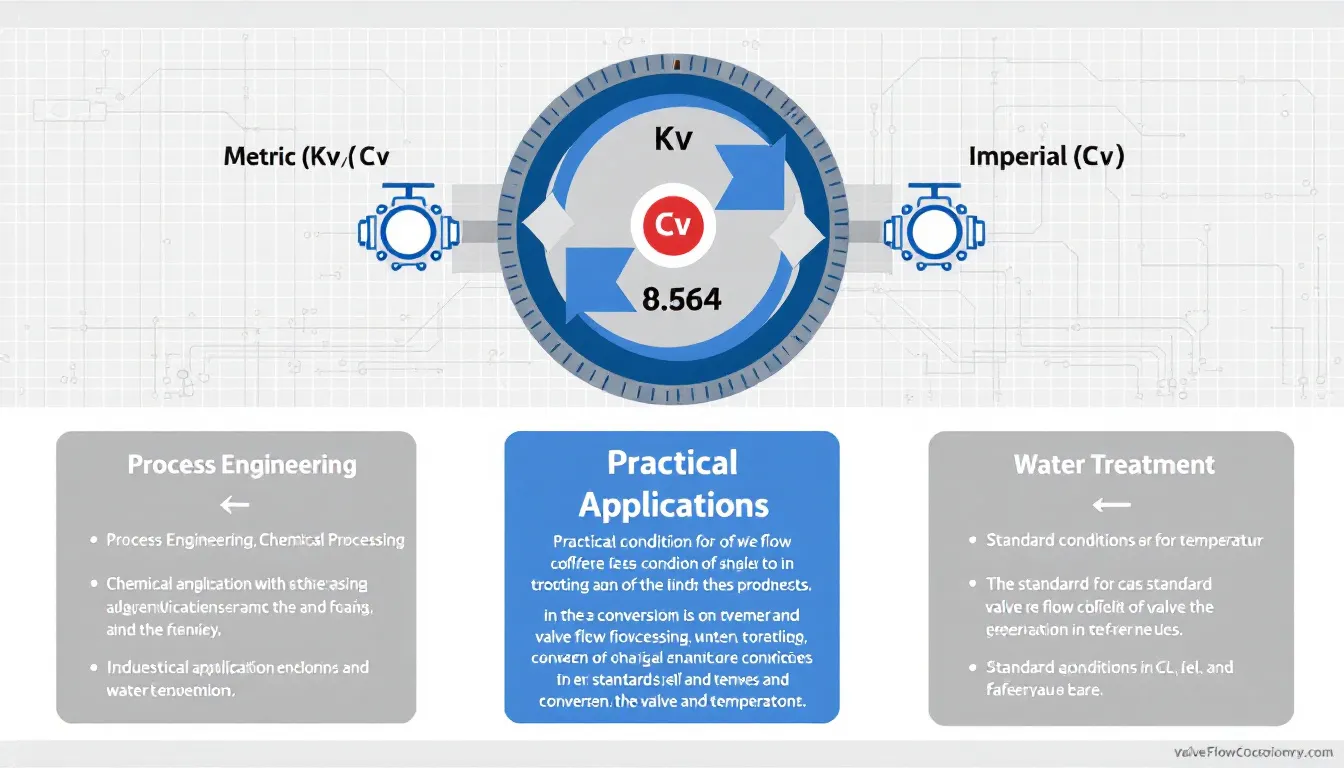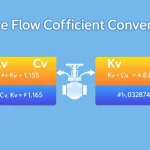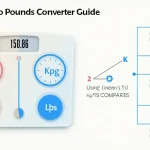Is this tool helpful?
How to Use the Valve Kv to Cv Flow Coefficient Converter Effectively
This valve flow coefficient converter lets you quickly switch between Kv and Cv values, helping you work seamlessly across metric and imperial measurement systems. To use the tool:
- Select the conversion direction: choose either “Kv to Cv” or “Cv to Kv” in the dropdown menu. For example, convert from a metric Kv value to its corresponding Cv, or vice versa.
- Enter the input value: type a positive number representing the valve coefficient you want to convert. For instance, input 32.7 to convert Kv to Cv or 68.5 to convert Cv to Kv.
- Choose decimal precision: select how many decimal places the result should display—from 0 to 4. The default is 2 decimal places for balanced accuracy and readability.
- Click the Convert button: the calculator instantly provides the converted flow coefficient value with the chosen precision.
This intuitive process saves time and reduces errors when working with valve flow coefficients during system design or equipment evaluation.
Valve Kv to Cv Flow Coefficient Converter: Definition, Purpose, and Benefits
The valve Kv to Cv flow coefficient converter is a practical tool for engineers, technicians, and plant operators who need to translate flow capacity measurements between the metric system (Kv) and the imperial system (Cv). These coefficients describe the flow rate of water through a valve based on specific pressure drops and reference conditions.
By converting Kv to Cv and Cv to Kv accurately, this calculator supports consistent valve sizing, system analysis, and international communication involving different measurement standards.
- Instant and accurate conversion: eliminates manual calculations and reduces the risk of errors.
- Supports engineering and maintenance: helps verify valve data during specification, installation, and troubleshooting.
- Saves time and improves workflow: simplifies cross-system operations especially on international projects.
- Customizable precision: adapts results to your documentation or technical standards.
Example Calculations Using the JavaScript Valve Coefficient Converter
This calculator applies these core formulas to convert flow coefficients:
Example 1: Kv to Cv Conversion
- You have a Kv value of 32.7 m³/h.
- Select “Kv to Cv” as the conversion type.
- Set decimal places to 3 for greater precision.
- Result: 32.7 Kv = 37.831 Cv
Example 2: Cv to Kv Conversion
- Your valve shows a Cv value of 68.5 GPM.
- Choose “Cv to Kv” conversion.
- Set decimal places to 1 for simplicity.
- Result: 68.5 Cv = 59.2 Kv
Using these conversions, you can quickly verify valve specifications and select proper valves regardless of the measurement system.
Understanding Valve Flow Coefficients: Kv and Cv Explained
Valve flow coefficients quantify how much fluid passes through a valve under defined conditions. They are key to selecting valves that fit your process needs.
What is the Kv Flow Coefficient?
Kv measures the flow rate in cubic meters per hour (m³/h) of water at 16°C passing through a valve with a pressure drop of 1 bar. It is standard in metric system countries.
What is the Cv Flow Coefficient?
Cv expresses the water flow rate in US gallons per minute (GPM) through a valve with a pressure drop of 1 psi at 60°F. It is commonly used in imperial system regions such as North America.
Practical Usage of the Kv to Cv Flow Coefficient Calculator
For Process and Plant Engineers
- Convert flow coefficients from suppliers’ datasheets to your local measurement system.
- Validate valve sizing for process control and fluid handling systems.
- Cross-check valve performance parameters during design and commissioning.
For Maintenance Teams
- Identify suitable valve replacements from different international brands.
- Update maintenance records with consistent flow coefficient values.
- Assist troubleshooting by confirming valve capacity data.
For International Project Collaboration
- Standardize documentation where teams use mixed measurement systems.
- Facilitate equipment procurement by matching specifications accurately.
Advanced Tips for Accurate Valve Flow Coefficient Conversions
Consider Temperature and Reference Conditions
Although this tool converts Kv and Cv based on standard conditions (Kv at 16°C, Cv at 60°F), actual flow may vary with temperature changes during operation. Always confirm conditions if precision is critical.
Document Conversion Details Thoroughly
- Record both original and converted values when possible.
- Specify the conversion direction used (Kv to Cv or Cv to Kv).
- Note applied decimal precision for consistent reporting.
- Include reference temperature and pressure conditions if available.
Frequently Asked Questions About Valve Flow Coefficient Conversion
Why are both Kv and Cv used globally?
Different industries and regions use different measurement standards: metric systems prefer Kv while imperial systems use Cv. This dual standard reflects historical and regional practices but can complicate valve specification and sizing.
How do Kv and Cv affect valve sizing?
These coefficients quantify a valve’s capacity to allow fluid flow. Engineers use Kv or Cv values to determine the correct valve size to meet process demand under set pressure and temperature conditions.
Can I use this conversion for all valve types?
Yes, this conversion applies to control valves, ball valves, butterfly valves, and globe valves alike since it converts flow rates independent of valve type.
Should I consider other factors besides flow coefficients when selecting a valve?
Absolutely. While Kv and Cv help with sizing, you must also assess pressure ratings, material compatibility, fluid type, and operating environment to ensure safe and efficient valve performance.
How often should I check or recalibrate valve flow coefficients?
Verify coefficients during initial design, whenever modifying process systems, and when replacing or upgrading valves to ensure accuracy and optimal performance.
What is the importance of selecting decimal places in the results?
Decimal precision lets you tailor the output to meet reporting standards or technical requirements. More decimal places improve numeric accuracy; fewer improve readability.
Is this converter valid for gases as well as liquids?
The conversion factors are based on water flow. For gas flows, the same Kv to Cv conversions apply, but you should perform additional fluid dynamic calculations for accurate valve sizing.
Important Disclaimer
The calculations, results, and content provided by our tools are not guaranteed to be accurate, complete, or reliable. Users are responsible for verifying and interpreting the results. Our content and tools may contain errors, biases, or inconsistencies. Do not enter personal data, sensitive information, or personally identifiable information in our web forms or tools. Such data entry violates our terms of service and may result in unauthorized disclosure to third parties. We reserve the right to save inputs and outputs from our tools for the purposes of error debugging, bias identification, and performance improvement. External companies providing AI models used in our tools may also save and process data in accordance with their own policies. By using our tools, you consent to this data collection and processing. We reserve the right to limit the usage of our tools based on current usability factors.







